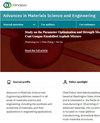Extraction and Characterization of Cellulose from Coffee Husk and Brewery’s Spent Grain Fibers Using Alkali-Hydrogen Peroxide Treatment Method
4区 材料科学
Q2 Engineering
引用次数: 0
Abstract
Coffee husk (CH) and brewery spent grain (BSG) fibers are sustainable industrial residues that consist of cellulose. The present study aimed at the extraction of cellulose from CH and BSG fibers and to study the effect of alkali-hydrogen peroxide (5% NaOH–7% H2O2) treatment during the extraction by characterizing the extracted cellulose. Characterization of cellulose particles, such as crystallinity, functional groups, thermal properties, and morphology, was conducted by performing X-ray diffraction (XRD), Fourier transform infrared spectroscopy (FTIR), thermogravimetric analyzer (TGA), and scanning electron microscopy (SEM), respectively. The finding shows that the maximum cellulose yields obtained from CH and BSG fibers are 37.3% and 26.5%, respectively. From the XRD results, the cellulose obtained from CH fiber (C-CH) and from BSG fiber (C-BSG) showed diffractive peaks with the highest intensity of approximately 1,003 and 1,236 counted at 2θ = 22°, respectively. A reduction in the absorption of peaks was observed on the FTIR spectrum for both C-BSG and C-CH samples at different wavelengths. SEM demonstrated that the surface roughness of the celluloses was enhanced. TGA showed that the maximum temperature decomposition observed for both C-CH and C-BSG is 360°C and 380°C, respectively. Generally, in this study, alkali-hydrogen peroxide (5% NaOH–7% H2O2) treatment was effectively used for the treatment of BSG and CH fibers for the extraction and surface modification of cellulose particles. The extracted cellulose in the present study can be used as an alternative to conventional cellulose for the manufacturing of biocomposite materials, preparation of particle boards and furniture, and production of food packaging materials.用碱液-过氧化氢处理法提取咖啡渣和啤酒糟纤维中的纤维素并确定其特性
咖啡壳(CH)和啤酒废谷(BSG)纤维是由纤维素组成的可持续工业残留物。本研究旨在从 CH 和 BSG 纤维中提取纤维素,并通过对提取的纤维素进行表征,研究提取过程中碱性过氧化氢(5% NaOH-7% H2O2)处理的效果。分别通过 X 射线衍射 (XRD)、傅立叶变换红外光谱 (FTIR)、热重分析仪 (TGA) 和扫描电子显微镜 (SEM) 对纤维素颗粒进行表征,如结晶度、官能团、热性能和形态。研究结果表明,CH 纤维和 BSG 纤维的纤维素产量最高,分别为 37.3% 和 26.5%。从 XRD 结果来看,从 CH 纤维(C-CH)和 BSG 纤维(C-BSG)中获得的纤维素在 2θ = 22° 处分别出现了强度最高的衍射峰,约为 1 003 个和 1 236 个。在不同波长的傅立叶变换红外光谱上,C-BSG 和 C-CH 样品的峰吸收率都有所下降。扫描电子显微镜(SEM)显示,纤维素的表面粗糙度有所提高。TGA 显示,C-CH 和 C-BSG 的最高分解温度分别为 360°C 和 380°C。总之,在本研究中,碱性过氧化氢(5% NaOH-7% H2O2)处理法被有效地用于处理 BSG 和 CH 纤维,以提取纤维素颗粒并对其进行表面改性。本研究中提取的纤维素可作为传统纤维素的替代品,用于制造生物复合材料、制备刨花板和家具以及生产食品包装材料。
本文章由计算机程序翻译,如有差异,请以英文原文为准。
求助全文
约1分钟内获得全文
求助全文
来源期刊

Advances in Materials Science and Engineering
Materials Science-General Materials Science
CiteScore
3.30
自引率
0.00%
发文量
0
审稿时长
4-8 weeks
期刊介绍:
Advances in Materials Science and Engineering is a broad scope journal that publishes articles in all areas of materials science and engineering including, but not limited to:
-Chemistry and fundamental properties of matter
-Material synthesis, fabrication, manufacture, and processing
-Magnetic, electrical, thermal, and optical properties of materials
-Strength, durability, and mechanical behaviour of materials
-Consideration of materials in structural design, modelling, and engineering
-Green and renewable materials, and consideration of materials’ life cycles
-Materials in specialist applications (such as medicine, energy, aerospace, and nanotechnology)
 求助内容:
求助内容: 应助结果提醒方式:
应助结果提醒方式:


